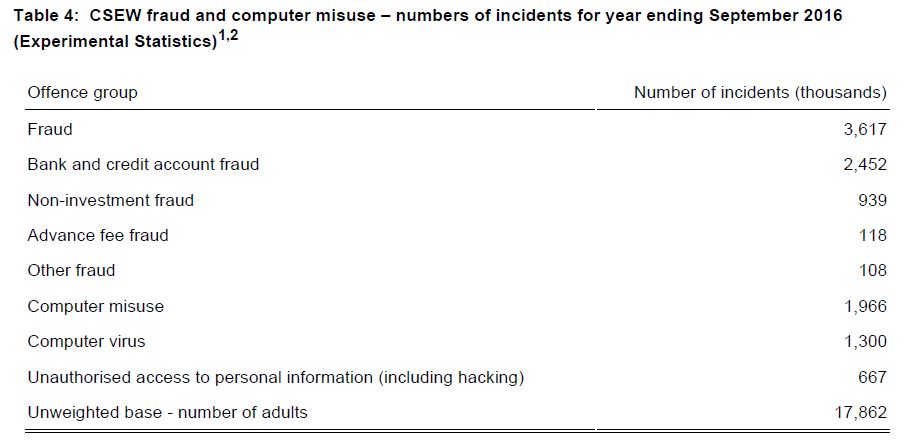Last week (19 January 2017), the Office for National Statistics published the latest crime figures for England and Wales which cover the year ending September 2016.
The statistics combine the findings from the Crime Survey for England and Wales (CSEW) and police recorded crime. CSEW figures tend to be higher as they are based on victims of crime and a significant proportion of crimes are never reported. They also tend to be more accurate in terms of measuring trends whereas police statistics can be influenced statistically by changes in recording definitions or practices.
Key findings:
- Headline figures from the CSEW showed an estimated 6.2 million incidents of crime in the survey year ending September 2016; no statistically significant change compared with the previous year’s survey.
- Experimental Statistics showed there were 3.6 million fraud and 2.0 million computer misuse offences for the first full year in which such questions have been included in the CSEW.
- The inclusion of these new offences yields a new headline estimate of 11.8 million incidents of crime, but it will be another year before a comparable time series is available.
- Trend data on frauds referred to the police showed an annual rise of 3%. Other industry data on financial fraud, the vast bulk of which is unreported to the police, showed there were 1.9 million cases of frauds on UK-issued cards (an increase of 39% from the previous year).
- Across all crime types, the police recorded 4.7 million offences in the year ending September 2016, an annual rise of 8%. Due to recording improvements affecting comparisons over time, this series is not currently a reliable measure of trends in crime.
- CSEW estimates showed no statistically significant change in levels of violence compared with the previous survey, with the underlying trend fairly flat in recent years.
- While the police recorded an annual rise of 22% in violent offences, the volume increases were largely driven by changes in recording processes and the inclusion of additional harassment offences.
- However, there appeared to be genuine smaller increases in some of the lower volume but higher harm categories of police recorded violence including homicide and knife crime.
Violent Crime
Violent crime covers a wide range of offences including minor assaults (such as pushing and shoving), harassment and abuse (that result in no physical harm) through to wounding and homicide. The Crime Survey for England and Wales (CSEW) provides the better measure of trends in overall violent crime. The police recorded crime series is restricted to violent offences that have been reported to and recorded by the police.
Over the longer-term, levels of violent crime estimated by the CSEW have shown substantial falls. These declines continued until 2014, after which estimates of violence from the CSEW have been fairly flat for the past two years. CSEW findings for the latest survey year show no change in levels of violence compared with the previous survey year (the apparent 4% increase was not statistically significant). Similar trends have also been demonstrated in accident and emergency department violence-related attendances and NHS hospital admissions for assault.
The police recorded 695 offences of homicide, 125 more than in the previous year (a 22% increase). However, this includes the 96 cases of manslaughter that resulted from the events in Hillsborough in 1989. Excluding those 96 cases of manslaughter, the increase in police recorded homicides is much lower, at 5%.
In the “violence with injury” category within police stats, there was a year-on-year increase of 12% – up to 449,844 offences. This increase includes a 23% rise in the number of attempted murder offences (a volume increase of 141) in the latest year; although these figures may also have been influenced by improvements in crime recording.
In the latest year, the police recorded an 11% increase in offences involving a knife or sharp instrument, compared with the previous year. While it is difficult to be certain what has driven this rise as these figures can be influenced by a wide range of factors, the available evidence suggests improvements in recording practices as well as an actual rise in knife crime are both likely to have contributed. Offences involving firearms in the latest year also increased, by 7% compared with the previous year.
Fraud:
The extent of fraud is difficult to measure because it is a deceptive crime; victimisation is often indiscriminate, covering organisations as well as individuals. Some victims of fraud may be unaware they have been a victim of crime, or that any fraudulent activity has occurred for some time after the event. Others might be unwilling to see themselves as victims or reluctant to report the offence to the authorities, feeling embarrassed that they have fallen victim. The level of fraud reported via administrative sources is thought to significantly understate the true level of such crime.
The most common types of fraud experienced are shown in the table below (“Non-investment” fraud is fraud related to online shopping or fraudulent computer service calls):
Other key findings relating to fraud were:
- The large majority of victims of fraud had been a victim only once (85%), with repeat victimisation in the same year more common among victims of bank and credit account fraud (14%) than non-investment fraud (9%).
- Two-thirds of fraud incidents involved initial loss of money or goods to the victim (66%), independent of any reimbursement received. This equates to an estimated 2.4 million offences, compared with 1.2 million incidents of fraud involving no loss.
- Where money was taken or stolen from the victim, in just under two-thirds of incidents the victim lost less than £250 (61%).
- The extent of cyber crime varied by type of offence, with three-quarters of non-investment frauds indicated by victims to have involved the use of the internet in some way (75%), compared with less than half of all bank and credit account frauds (45%).
Analysis:
The latest set of crime figures are typical of recent quarterly reports — overall crime has stopped falling but is pretty stable.
There are possible indications that some categories of violent crime may be rising with the main concern being the increase in the use of weapons.
We are only just starting to explore the real extent of cybercrime (online fraud and computer offences) and it may be a year or two before we get an accurate picture of the extent of this crime and whether, as many suspect, it is growing exponentially.
This article originally appeared on russellwebster.com
Russell Webster is a blogger with over thirty years experience working in the drugs, alcohol and crime fields. He is an expert in payment by results and the strategic use of social media


